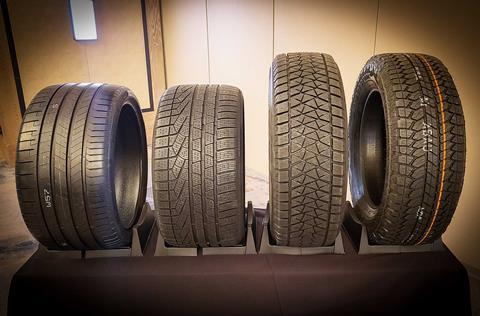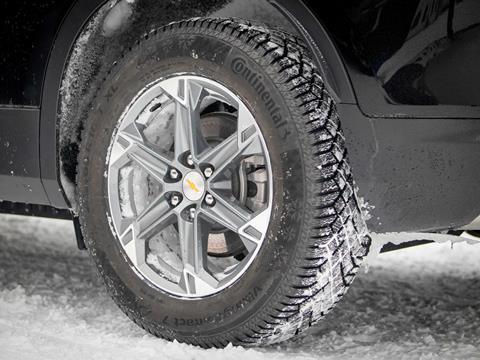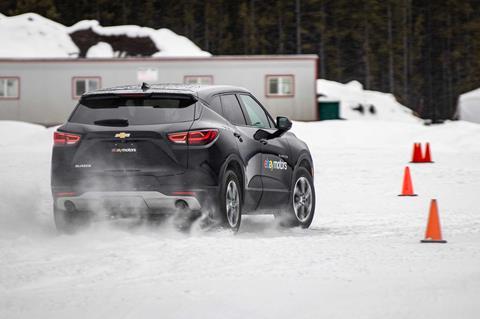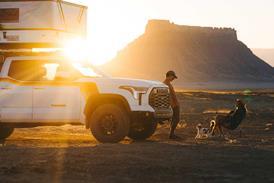A lot of adventurers realize the need for all-terrain or mud-terrain tires, but what about winter tires? The fact is if you’re driving in temperatures below 45°F, many tires simply don’t perform as well as a dedicated winter or snow tire.
I recently traveled to Montana to partake in winter tire testing with the crew from eBay Motors. Here, we drove four vehicles, each had a set of all-season or all-terrain tires and a set of winter rubber. In case you forgot: winter tires are way better in the snow than regular tires. But how much better? And why are they better?

We arrived at the snow-covered Yellowstone Airport and were presented with four different courses, each highlighting a unique scenario to highlight why winter tires were better in frigid temps. From a moose-avoidance test and icy braking demo to a full-on snow-cross course and even driving a Porsche 911 on a wintery slalom layout: these tests were designed to showcase how good winter tires are compared to non-winter rubber in the snow and cold.
Why Winter Tires Are Better
If you live in a cold, snowy, icy climate where temps fall below that magic 45° F temp, winter tires are going to perform better than non-winters. Buy why?
There are two reasons: rubber compound and tread design. A snow tire’s rubber is going to be formulated with softer rubber. And while they won’t have the life expectancy of an all-season or all-terrain tire, a winter tire is made for a specific use.
All-season and all-terrain tires are jacks of all trades, but don’t do any one thing exceptionally. Winter tires are made specifically to excel in winter driving conditions. Period. Yes, they’ll wear faster in warm temps, can be noisier, and should be swapped for other rubber when it’s not winter. But in the snow, slush, ice, and cold—they’re specialists and can help to keep you safer.

A winter tire’s tread design is different than other tires. They have more blocks and sipes. Sipes are slices in tread blocks designed to splay out for more traction and to channel water, snow, and slush away from the tire. Sipes can also grab onto snow. Ever made a snowball? Snow sticks to snow, and that is part of the idea with a snow tire, as snow + snow = grip.
The eBay Motors crew set up four stations, each with two of the same vehicles. However, one vehicle had non-winter tires, the other had winter tires. Each station also set out to bust a myth about driving in the winter.
Iced-Out Sedan
I started the day on an ice test. We hopped in a front-drive Toyota Camry equipped with high-performance Yokohama ADVAN Apex V601 summer tires. The myth? Running a lower rear tire pressure can help with traction. (I’m not sure who’s myth this was, but whatever.)

Even making our way from the snow-covered parking area to the starting line was a challenge on the ADVAN summer tires. I accelerated to about 20 MPH on a sheet of ice (which was difficult), then slammed on the brakes in an effort to stop as quickly as possible. The results were not impressive.
Then the driving instructor and I hopped in the sedan with a set of Yokohama iceGUARD IG53 tires. Needless to say, the car accelerated and braked considerably better than the factory high-performance Yokohama ADVAN rubber.
Frankly, tires made from recycled bowling balls would’ve probably been better on the ice than an ultra-high-performance summer tires. But this was not surprising and it proved a point. Also, our lower rear tire pressure myth? Busted. It did little if anything.
A 911 Snow Slalom
Next, I went to a slalom course where we’d attempt to pilot a rear-drive 2023 Porsche 911 Carrera Cabriolet around a snowy layout. The myth? Rear-drive sports cars can’t drive in the snow. The factory ultra-high-performance Pirelli P-Zero PZ4 tires couldn’t even move the sports car forward more than a couple of feet in the snow. So yeah, the myth held up here.

However, when the Porsche was equipped with Pirelli Winter Sottozero Seire II winter tires, the car became not only drivable, but a blast to hoon around the autocross course, drifting sideways, and throwing up snow behind it.
This was literally the difference between going and not going … anywhere. How does a Porsche example apply to those of us piloting adventure vehicles? Even in a two-wheel drive truck or SUV, having snow tires can make a night and day difference in traction.
An F-150 And the Snow-Cross Course
Up next was the snow-cross course in a 2023 Ford F-150 SuperCrew Lariat 5.0L 4x4. Here, we piloted a pickup on Bridgestone Dueler A/T RH-S all-terrain tires with 600 lbs. of weight in the rear in an effort to add traction. I mean, you can’t argue against physics here, right? In four-high, the truck made it around the track without any real issues, per se. There was quite a bit of understeer in corners, but the truck was able to make it around without getting stuck.

However, getting in the same vehicle equipped with Bridgestone’s Blizzak DM-V2 snow tires (at the same tire pressure but without the weight), the F-150 was transformed from an a paltry pickup into a veritable snowmobile.

The winter tires made a massive difference in the ability to accelerate, take snowy corners, and brake in the packed snow. It was really noticeable. FYI, the Dueler A/T RH-S tires weren’t 3PMS (3 peak mountain snowflake) rated. Even if they had been, the dedicated winter tire is still going to offer up better winter traction.
This was the most relatable tire test for me, the owner of five 4WD vehicles. While many immediately think 4WD is good in the snow, a 4WD on the right tires is a force to be reckoned with.
The Moose Maneuver
Finally, it was over to the moose avoidance test. While no moose were actually employed, I got into a 2023 Chevrolet Blazer equipped with Continental CrossContact LX Sport all-season tires and one with Continental VikingContact 7—perhaps the most aptly named winter tire ever. Here, we accelerated in a straight line, then the driving instructor would yell out either “left!” or “right!” and I had to perform an emergency lane change maneuver around cones.

As you’d guess, the VikingContact 7 snow tires provided exponentially better initial traction and emergency handling than the all-season rubber.

We also got a third run in this test with traction control off. On all-season tires, the massive wheelspin barely allowed you to get up to speed. Overall vehicle control was subpar. But—you guessed it—the winter tires were vastly superior and control was far greater.
I could really see how in an emergency maneuver, winter tires could be the difference between hitting wildlife or avoiding them. While a front-drive Blazer may not be the adventure vehicle of choice these days, the test showcased how, yet again, a winter tire can make a difference in handling, control, and safety.
Winter Tires for The Win
I lived in Minnesota and Wisconsin for over 28 years and grew up driving in wintery conditions. Ironically, I never utilized snow tires until right before leaving the Midwest. My first experience with them in the late 2000s immediately convinced me that winter rubber could turn nearly any vehicle into a snow-goer. I was a convert.

Getting behind the wheel at this event provided a controlled environment to really see and feel the difference good winter rubber can make for winter travel. From emergency lane changes to curvy roads; ice-covered tracks to quick winding back roads, winter tires proved exponentially better when the temps drop and the roads get bad. In fact, fellow OVR feature editor (and my wife), Mercedes Lilienthal, and I will be running Michelin X-Ice winter tires on the 2024 INEOS Grenadier on the upcoming Alcan 5000 winter rally.
The folks at eBay Motors told us there are over a million tire listings at the online marketplace as well as an installer program. So those who’d like to purchase new tires—winter or otherwise—can buy on eBay, have the tires shipped to an installer, and have the tires mounted and balanced. This was something I was unaware of but could benefit those looking to purchase their next set of tires (winter or otherwise) from eBay Motors’ online merchants.
But if anything, these tests confirmed what, in practice, we all know: winter tires are better in winter driving conditions. But many drivers don’t actually have the right tires for the right conditions. Nevertheless, if they could get behind the wheel like I did, maybe they’d see that an investment in winter rubber for cold, ice, slush, and snow might just lead to safer roads and fewer injuries, and I think that’s something we could all benefit from no matter what we drive.
Access More Great Stories!
For more informative articles like this, consider subscribing to OVR Magazine in print or digital versions here. You can also find the print edition of OVR at your local newsstand by using our Magazine Finder.





















No comments yet